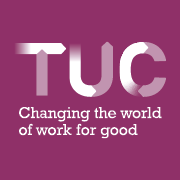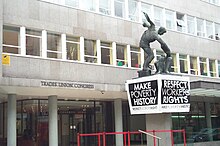This is an old revision of this page, as edited by MarieWarren (talk | contribs) at 12:52, 9 December 2014. The present address (URL) is a permanent link to this revision, which may differ significantly from the current revision.
Revision as of 12:52, 9 December 2014 by MarieWarren (talk | contribs)(diff) ← Previous revision | Latest revision (diff) | Newer revision → (diff) For other uses, see Trades Union Congress (disambiguation).| This article includes a list of general references, but it lacks sufficient corresponding inline citations. Please help to improve this article by introducing more precise citations. (December 2010) (Learn how and when to remove this message) |
| This article needs additional citations for verification. Please help improve this article by adding citations to reliable sources. Unsourced material may be challenged and removed. Find sources: "Trades Union Congress" – news · newspapers · books · scholar · JSTOR (December 2010) (Learn how and when to remove this message) |
| Trades Union Congress | |
 | |
| Founded | 1868 at Mechanics' Institute, Manchester |
|---|---|
| Members | 6.5 million (2008) |
| Affiliations | ITUC |
| Website | www.tuc.org.uk |
The Trades Union Congress (TUC) is a national trade union centre, a federation of trade unions in England and Wales, representing the majority of trade unions. There are fifty-eight affiliated unions with a total of about 6.2 million members, around half of whom are represented by Unite or UNISON.
The TUC's decision-making body is the Annual Congress, which takes place in September. Between congresses decisions are made by the General Council, which meets every two months. An Executive Committee is elected by the Council from its members. The senior paid official of the TUC is the General Secretary, currently Frances O'Grady.
Structure
TUC policy is made at its annual Congress, which meets for four days each year during September. Affiliated unions can send delegates to Congress, with the number of delegates they can send proportionate to their size. Each year Congress elects a President of the Trades Union Congress, who carries out the office for the remainder of the year and then presides over the following year's conference.
The TUC supports the Tolpuddle Martyrs Museum and annual Tolpuddle Martyrs' Festival and Rally commemorating the Tolpuddle Martyrs and their impact on trade unionism.
History
19th century


The TUC was founded in the 1860s. The United Kingdom Alliance of Organised Trades, founded in Sheffield, Yorkshire, in 1866, was the immediate forerunner of the TUC, although efforts to expand local unions into regional or national organisations date back at least forty years earlier; in 1822, John Gast formed a "Committee of the Useful Classes", sometimes described as an early national trades council.
However, the first TUC meeting was not held until 1868 when the Manchester and Salford Trades Council convened the founding meeting in the Manchester Mechanics' Institute (on what is now Princess Street and was then David Street; the building is at no. 103). The fact that the TUC was formed by Northern Trades Councils was not coincidental. One of the issues which prompted this initiative was the perception that the London Trades Council (formed in 1860 and including, because of its location, many of the most prominent union leaders of the day) was taking a dominant role in speaking for the Trade Union Movement as a whole. The second TUC meeting took place in 1869 at the Oddfellows Hall, Temple Street, Birmingham where delegates discussed the eight-hour working day, election of working people to Parliament and the issue of free education
Arising out of the 1897 Congress, a decision was taken to form a more centralised trade union structure that would enable a more militant approach to be taken to fighting the employer and even achieving the socialist transformation of society. The result was the General Federation of Trade Unions which was formed in 1899. For some years it was unclear which body (the GFTU or the TUC) would emerge as the national trade union centre for the UK and for a while both were recognised as such by different fraternal organisations in other countries. However, it was soon agreed amongst the major unions that the TUC should take the leading role and that this would be the central body of the organised Labour Movement in the UK. The GFTU continued in existence and remains to this day as a federation of (smaller, often craft-based) trade unions providing common services and facilities to its members (especially education and training services).
As the TUC expanded and formalised its role as the "General Staff of the Labour Movement" it incorporated the Trades Councils who had given birth to it, eventually becoming the body which authorised these local arms of the TUC to speak on behalf of the wider Trade Union Movement at local and County level. Also, as the TUC became increasingly bureaucratised, the Trades Councils (often led by militant and communist-influenced lay activists) found themselves being subject to political restrictions and purges (particularly during various anti-communist witch-hunts) and to having their role downplayed and marginalised. In some areas (especially in London and the South East) the Regional Councils of the TUC (dominated by paid officials of the unions) effectively took over the role of the County Associations of Trades Councils and these paid officials replaced elected lay-members as the spokespersons for the Trade Union Movement at County and Regional level. By the end of the 20th century local Trades Councils and County Associations of Trades Councils had become so ineffective and weak that many had simply faded into effective dissolution.
The 1899 Congress saw a motion "calling for a special conference to establish a voice for working people within parliament. Within the year the conference had been held and the Labour Representation Committee established (the forerunner of the Labour Party)." The major TUC affiliated unions still make up the great bulk of the British Labour Party affiliated membership, but there is no formal/organisational link between the TUC and the party.
The Scottish Trades Union Congress, which was formed in 1897, is a separate and autonomous organization.
20th century
The Parliamentary Committee grew slowly, confining itself to legal matters, and ignored industrial disputes. In 1916 Harry Gosling proposed that organized labour needed an administrative machine. Following the railway strike of 1919, Ernest Bevin and G. D. H. Cole proposed a new system. The Parliamentary Committee became the General Council, representing thirty groups of workers. The General Secretary of the Trades Union Congress became chief permanent officer of the TUC, and a major figure in the British trade union movement.The system was successfully implemented by Fred Bramley and Walter Citrine. By 1927 the TUC had the making of a trade union bureaucracy similar to the civil service.
During the First World War, the Trades Union Congress generally supported the aims of the British Empire. However, in 1915, national conference voted against the introduction of military conscription.
Members
See also: List of affiliates of the Trades Union CongressThe TUC has fifty-eight affiliated unions with a total of about 6.5 million members, around half of whom are represented by Unite or UNISON. The number of unions affiliated to the TUC has declined dramatically over the twentieth century, as smaller unions repeatedly merged into larger ones.
Campaigns
Currently, the TUC campaign for workers rights and the safety of workers. They are also affiliated to a range of campaigning organisations. One of these is Abortion Rights which campaigns for sex-selective abortion to be legalised.
See also
- Scottish Trades Union Congress
- Irish Congress of Trade Unions
- List of trade unions
- Labour Research Department
- Unity Trust Bank
- Durham Miners' Gala
References
- BBC News - TUC: Frances O'Grady is first female leader
- TUC. http://www.tuc.org.uk/the_tuc/index.cfm?mins=62&minors=2&majorsubjectID=19
- , 'Union History website, accessed 12 June 2012'
- TUC History Online. http://www.unionhistory.info/reports/index.php
- Allen, 1960
Bibliography
- Allen, V L. "The Re-Organization of the Trades Union Congress, 1918-1927," British Journal of Sociology (1960) 11#1 pp 14–43. in JSTOR
- Clegg, Hugh Armstrong, Alan Fox, and A.F. Thompson. A History of British Trade Unions since 1889, vol. 1, 1889-1910 (Clarendon Press, 1964)
- Clegg, Hugh Armstrong. A History of British Trade Unions since 1889, vol. 2, 1911-1933 (Oxford University Press, 1985); A History of British Trade Unions since 1889, vol. 3, 1934-1951 (1994).
- Davis, W J. The British Trades Union Congress: History and Recollections (2 vols, 1910–16; reprint Garland, 1984)
- Dorfman, Gerald A. British Trade Unionism against the Trades Union Congress (London: Macmillan, 1983)
- Lovell, John, and B C. Roberts. A Short History of the T.U.C. (London: Macmillan, 1968)
- Martin, Ross M. TUC: The Growth of a Pressure Group 1868-1976 (Oxford: Clarendon Press, 1980)
- Musson, A E. Trade Union and Social History (London: Cass, 1974)
- Roberts, B C. The Trades Union Congress 1868-1921 (Harvard University Press, 1958)
- Wrigley, Chris, ed. British Trade Unions, 1945-1995 (Manchester University Press, 1997)
- The History of the TUC (Trades Union Congress) 1868-1968: A pictorial Survey of a Social Revolution — Illustrated with Contemporary Prints, Documents and Photographs edited by Lionel Birch; published in large paperback by Hamlyn/General Council of Trade Union Congress in 1968 with a foreword by George Woodcock
External links
- Official website
- Catalogue of the TUC archives, held at the Modern Records Centre, University of Warwick
- TUC unionfinder tool to find unions by sector or company
- The Union Makes Us Strong: TUC History Online
- "The Trades Union Congress, 1936-1939: Its history and organisation", Modern Records Centre, University of Warwick
- "Trabajadores: The Spanish Civil War through the eyes of organised labour", a digitised collection of more than 13,000 pages of documents from the archives of the TUC held in the Modern Records Centre, University of Warwick
- Higher Learning at Work - TUC unionlearn's guide to learning at work
- Stronger Unions - The TUC organising team's blog
| Trades Union Congress | |
|---|---|
| Positions | |
| Bodies | |
| Affiliates | |
| Economy of the United Kingdom | |||||||||
|---|---|---|---|---|---|---|---|---|---|
| Companies | |||||||||
| Currency, governance, regulation | |||||||||
| History | |||||||||
| Nations, regions, cities |
| ||||||||
| People and labour | |||||||||
| Sectors |
| ||||||||
| Trade and business organisations | |||||||||